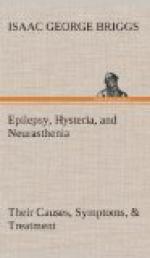The convulsions are followed by temporary paralysis of the involved muscles, but power finally returns. As we should expect, this paralysis lasts longest in the muscles first involved, and is slightest in the muscles whose brain-centres were irritated by the nearly exhausted waves. If the disease be untreated, the muscles in time may become totally paralysed, wasted, and useless.
Friends should very carefully note exactly where and how the attack begins, the exact part first involved, and the precise order in which the spasms appear, as this is the only way the doctor can localize the brain injury. The importance of this cannot be overrated.
The consulting surgeon will say if operation is, or is not, advisable, but operation is the sole remedy for Jacksonian epilepsy, for the causes that underly its symptoms cannot be reached by medicines.
Patients must consult a good surgeon; other courses are useless.
Psychic or Mental Epilepsy is a trance-state often occurring after attacks of grand or petit mal, in which the patient performs unusual acts. The epileptic feature is the patient’s inability to recall these actions. The complaint is fortunately rare.
The face is usually pale, the eyes staring, and there may be a “dream state”. Without warning, the victim performs certain actions.
These may be automatic, and not seriously embarrassing—he may tug his beard, scratch his head, hide things, enter into engagements, find the presence of others annoying and hide himself, or take a long journey. Such a journey is often reported in the papers as a “mysterious disappearance”. Yet, had he committed a crime during this time, he would probably have been held “fully responsible” and sentenced.
The actions may be more embarrassing: breaking something, causing pain, exhibiting the sexual organs; the patient may be transported by violent rage, and abuse relatives, friends or even perfect strangers; he may spit carelessly, or undress himself—possibly with a vague idea that he is unwell, and would be better in bed.
Finally the acts may be criminal: sexual or other assault, murder, arson, theft, or suicide.
In this state, the patient is dazed, and though he appreciates to some extent his surroundings, and may be able to answer questions more or less rationally, he is really in a profound reverie. The attack soon ends with exhaustion; the victim falls asleep, and a few moments later wakes, ignorant of having done or said anything peculiar.
We usually think of our mind as the aggregate of the various emotions of which we are actually conscious, when, in reality, consciousness forms but a small portion of our mentality, the subconscious—which is composed of all our past experiences filed away below consciousness—directing every thought and act. Inconceivably delicate and intricate mind-machinery directs us, and our idlest fancy arises, not by chance as most people surmise, but through endless associations of subconscious mental processes, which can often be laid bare by skilful psycho-analysis.




